I love it when lessons I taught in my biology and zoology classes play out in my photography.
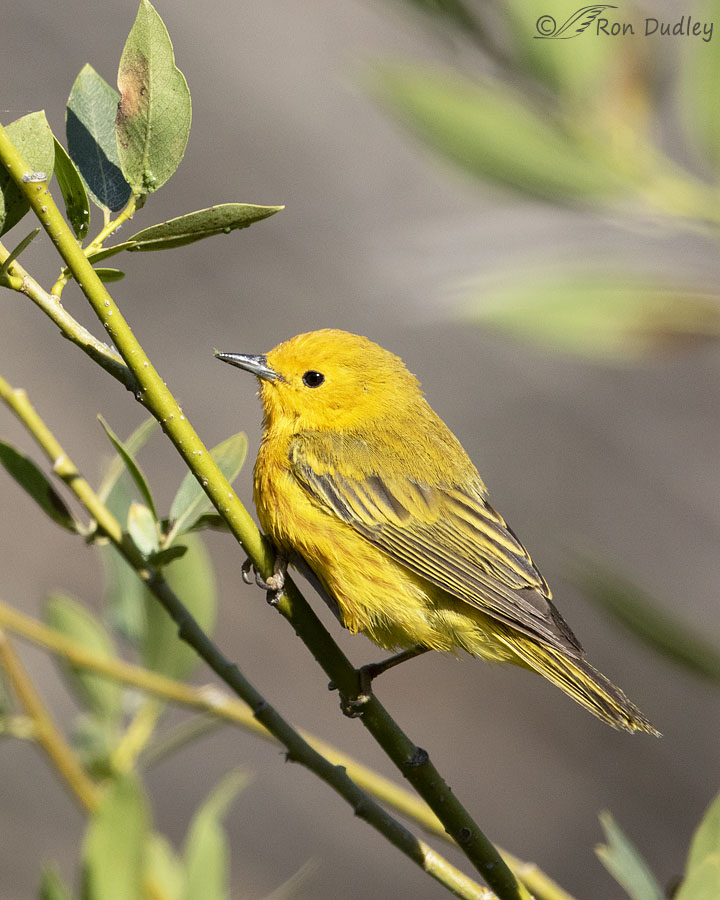
Yesterday morning this Yellow Warbler was foraging for insects in the mountains. There was a single tiny aphid on the end of his bill but he had a hankering for more.
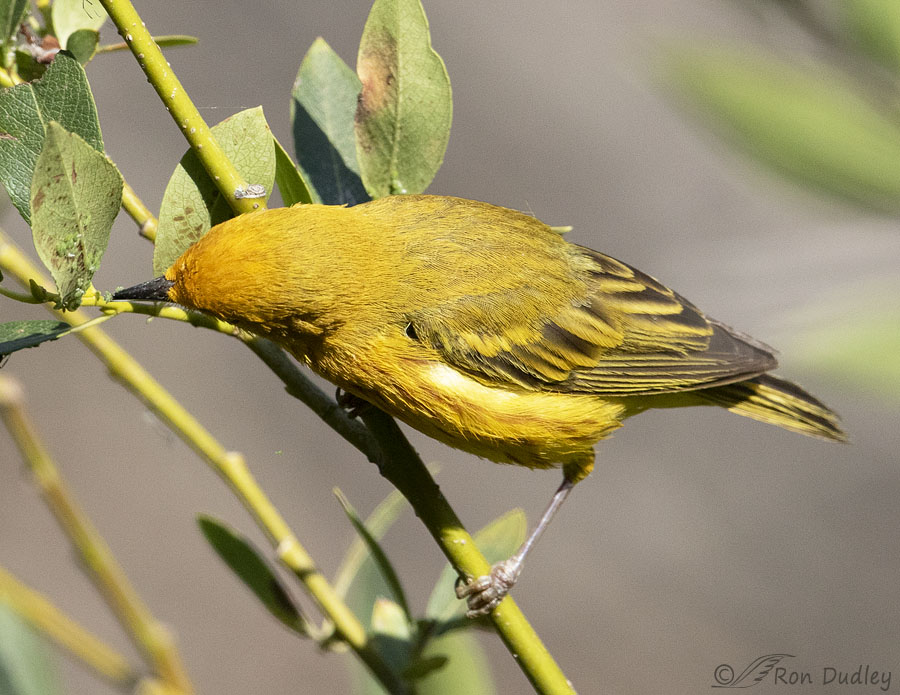
So he walked a couple of steps higher on the stem and began to harvest a clump of aphids at the base of this leaf.
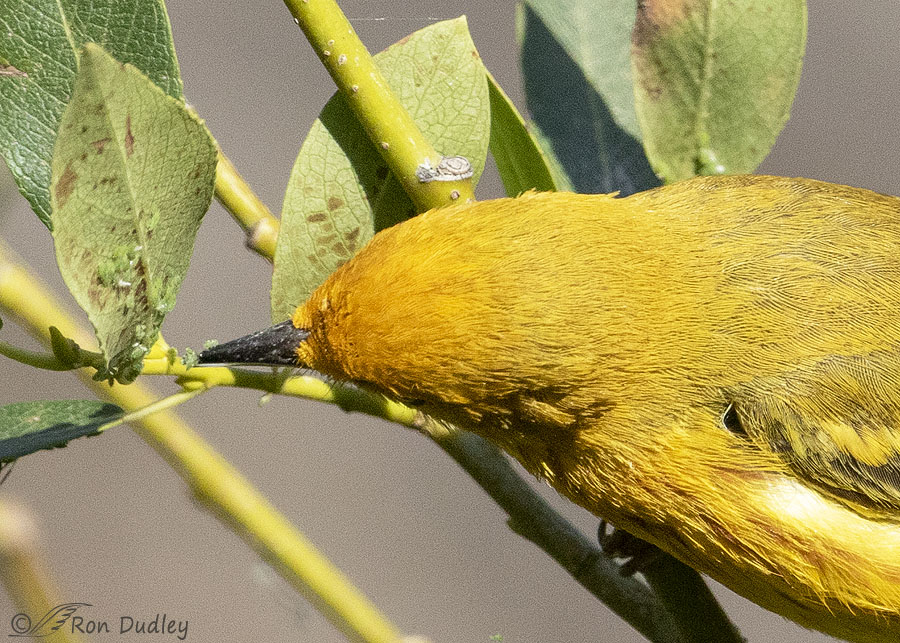
An even tighter crop gives us a better look at the aphids even though they aren’t as sharp as they could be because my active focus point was on the bird’s back. When I took the photo I didn’t even know the aphids were there.
It was only by chance that I discovered that there’s probably more going on here than was initially apparent in this version of the photo. I wanted to see how sharp the aphids really were (not very) so I zoomed in about as close as I could.
In this different crop of the same photo clusters of ants right next to the aphids became apparent. They were in deep shade on the undersides of the leaves so most of them were hard to see until I increased the exposure of the shadows during processing.
I believe the aphids were probably being ‘farmed’ by the ants as they cared for and protected them and consumed the honeydew they produce. Ants that do this are sometimes called “dairying ants” because they literally milk the aphids of their honeydew. I believe that it’s probably more than just a coincidence that the ant clusters were so close to the aphids.
This from Wikipedia if you could use a refresher course on ant/aphid mutualism.
Some species of ants farm aphids, protecting them on the plants where they are feeding, and consuming the honeydew the aphids release from the terminations of their alimentary canals. This is a mutualistic relationship, with these dairying ants milking the aphids by stroking them with their antennae. Although mutualistic, the feeding behavior of aphids is altered by ant attendance. Aphids attended by ants tend to increase the production of honeydew in smaller drops with a greater concentration of amino acids.
Some farming ant species gather and store the aphid eggs in their nests over the winter. In the spring, the ants carry the newly hatched aphids back to the plants. Some species of dairying ants manage large herds of aphids that feed on roots of plants in the ant colony. Queens leaving to start a new colony take an aphid egg to found a new herd of underground aphids in the new colony. These farming ants protect the aphids by fighting off aphid predators.
I don’t know for fact that these ants were farming the aphids but I strongly suspect they were.
Ron
Oh, and by the way…
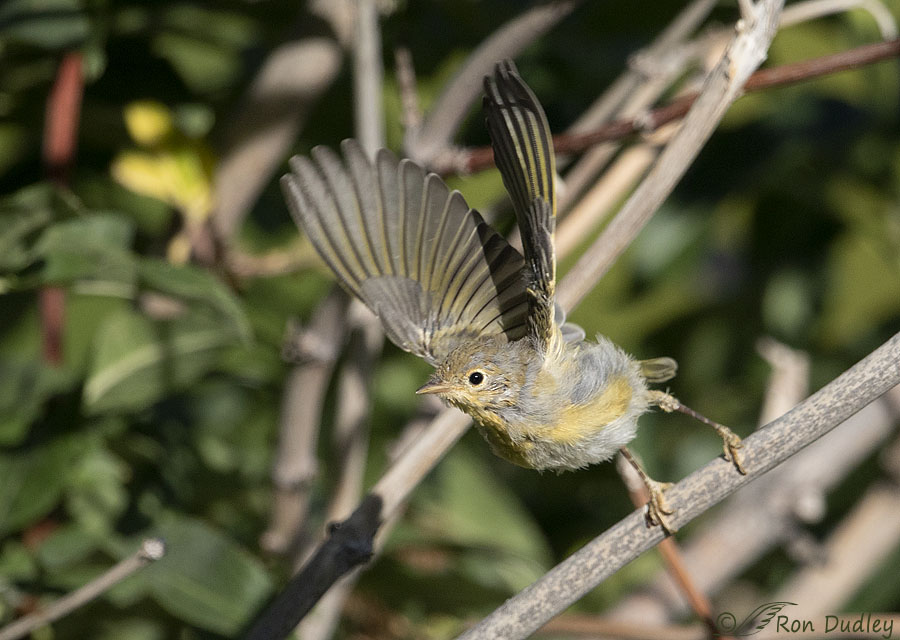
recently fledged Yellow Warbler chicks are common in the mountains right now. This one, still half-covered with down, could already fly like a champ.


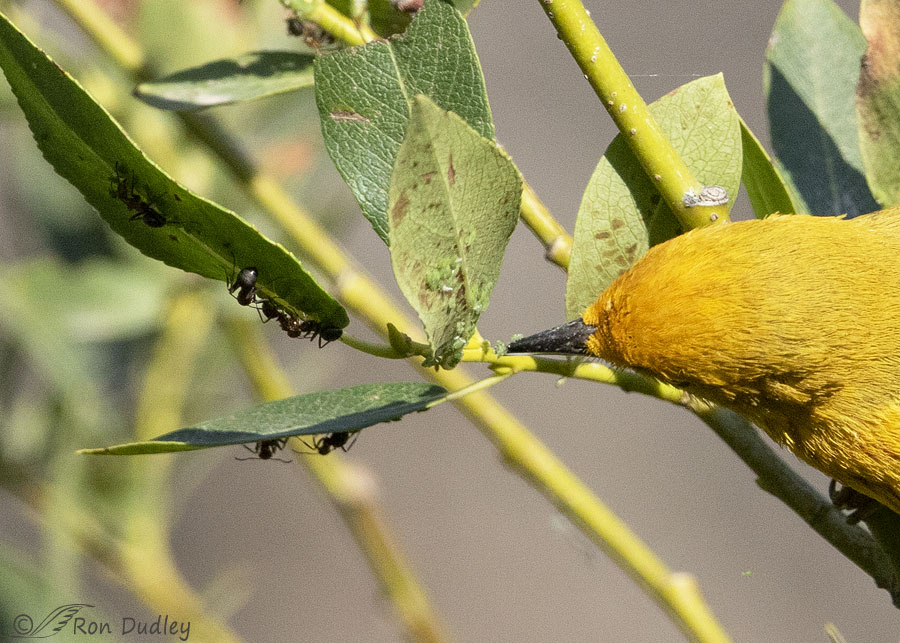
Late to the party for a variety of reasons this morning (tech/pain mostly) but so very glad to be here. The yellow warbler is a delightful splash of sunshine.
I have heard of ants ‘farming’ aphids but have not seen it. Huge thanks for the lesson – and more thanks for the small piece of feathered enchantment to finish the post on.
Thanks, EC. I’ve been lucky enough to see it fairly often..
Thanks Ron. Seems like there are a profusion of yellow warblers up here at Parley’s Summit. Is that your experience too? And, if so, is that experience in the Wasatch Back?
Yes to both of your questions, Art.
Another old biology teacher signing in! I used to live for those “teachable moments!” Actually, I still do — and woe to hubby or friends within earshot when I come across some wonder of nature.
I used to live for those “teachable moments!” Actually, I still do — and woe to hubby or friends within earshot when I come across some wonder of nature. 
One of the things I do miss about teaching is taking a field trip. We used to do field trips comparing rocky shore, sandy beach, and salt marsh ecosystems, another one to the San Diego Wild Animal Park to go through their CRES facilities and the park, and a more integrated one to Balboa Park — Air & Space Museum and Globe Theater (math, coordinated science, IT, and English), among others. You and Dick have brought back some fun memories!
Marty, I took my high school kids on various field trips but for 12 years I was literally immersed in field trips when I worked for the Museum of Natural history in summers. We went all over the state and several nearby states on full day and two day field trips with kids who signed up for their Junior Science Academy. We had a biologist (me), an anthropologist and a geologist leading the trips and there were always 36 kids who had signed up for them. We all learned a lot – me in particular, from the anthropologist and the geologist. Great times but we had some pretty dramatic adventures too…
I would LOVE to do something like this!!!
I’m sure glad I did it but I’m too damned old for sleeping on the ground now, that’s for sure.
That is truly fascinating stuff to learn — I was NOT a good biology/science student — but regardless, ants and aphids are the bane of my existence (at least in the backyard) and I’m rooting for the beautiful warbler to do ‘em all in!
And that fledgling …
Thanks, Chris. I don’t have too much trouble with ants but some years aphids are very destructive to my roses. I’ve given up on Impatiens for the same reason.
Thanks for showing so well what another old biology teacher (me) tried to show students whenever possible. Nature is always full of wonder.
Geez, old bio teachers are everywhere around here! Thank you, Dan.
Looks like the protector role the ants perform has its limits. The fledgling is splotchily adorable.
“Looks like the protector role the ants perform has its limits”
For sure. I actually wondered if the ants took cover and hid in the shade under the leaves when they saw the warbler coming as he worked his way up the branch.
Great shots and I love the fledgling! I have seen woodpeckers and sap suckers eat both the aphids and the ants farming them. Their long sticky (barbule) tongue is very efficient.
Thanks, April. I’ve seen the same thing.
Well, here’s a WOW from a completely different perspective! Since I had a LOUSY high school biology teacher who was one of the reasons I just quit the whole high school thing, I had no idea about this mutualism with ants and aphids! So, as with every other bit of new information, that just brings up a bunch of new questions. Doesn’t the whole idea of farming indicate a higher intelligence among the ants and maybe the aphids, too? After all, that’s a survival choice that requires a level of expertise (if you will) within both the ant and aphid cultures/colonies along with ongoing generational training to carry the practice forward. And what about the cultural/class implications that might happen that differentiates farmers from workers, etc.? Consider my mind blown with all the implications involved here!! I just love, Love, LOVE learning new stuff!!
The baby warbler is a HUGE bonus! What a cutie!
“Doesn’t the whole idea of farming indicate a higher intelligence among the ants and maybe the aphids, too?”
Laura, I believe it’s instinct rather than intelligence in both the ants and the aphids.
I wish you had a better experience with your biology teacher but sadly there’s some of “that type” in every discipline.
.
So awesome to imagine the ants “stroking” the aphids! As a former goat and cow milker I loved this. Thank you for another wonderful post, Ron!
Mary, I’ve never milked goats but I had some experience with milking cows as a kid. At least ants don’t have tails – our milk cow just loved to whip me with her tail during the hand milking process. It stung like hell.
Never done it but sure have heard the stories of how they do a “gotcha”……
Judy, I’m sure she figured that if I was going to poke around her udder like that (at my age I wasn’t very good at milking) I deserved to pay a price for my incompetence.
Ah yes, memories of field trips and trail excursions with my biology/ecology students teaching them mutualism. Wonderful images, many thanks for your shots and bringing back the memories!
One of the things us old life science teachers have in common isn’t it, Dick.
I have to wonder whether field trips will become more common and thus more important in this time of the pandemic and back to school. At least with the schools that can take kids on field trips. All kinds of lessons can be taught on these field trips!!
I have seen this ‘farming practice’ by the ants; It was mentioned in my horticulture class on insects/plants. It is quite interesting to read about the relationship and how the ants control. I know I’ve said it before but nature is wonderful. Love the photo of the juvenile warbler.
I’ve seen it too, Kathy. I get the impression it’s relatively common.
Interesting! I know the ants do that even on the water lily leaves in my pond which I DON’T appreciate! I often wonder just how the ants get there when there are no leaves toughing the edge when they first appear……. Ants DO love the honeydew as witnessed by them working peony buds and, not, the peonies don’t “need” them to open the flowers….
I often wonder just how the ants get there when there are no leaves toughing the edge when they first appear……. Ants DO love the honeydew as witnessed by them working peony buds and, not, the peonies don’t “need” them to open the flowers….  Fun and educational post Ron……
Fun and educational post Ron…… 
Thanks, Judy. If I remember correctly at least some ants can swim and they all float on water.
Ah! Did know they “float” – Thx!
An excellent biology lesson Ron. I am familiar with ants always being present when we have aphids on our roses etc, but I just assumed the ants ate the aphids. Definitely new knowledge for me. Will pass on to my wife who has a degree in Ornamental Horticulture to see if her knowledge of aphids goes that deep. Oh, and the Warbler chick is a bonus. What a great shot. Too precious.
Thanks, Everett. He’s a cute little guy isn’t he.
Very cool! Ants are pretty impressive insects, and it’s always nice to see a fledgling.
Thank you, Cathy.